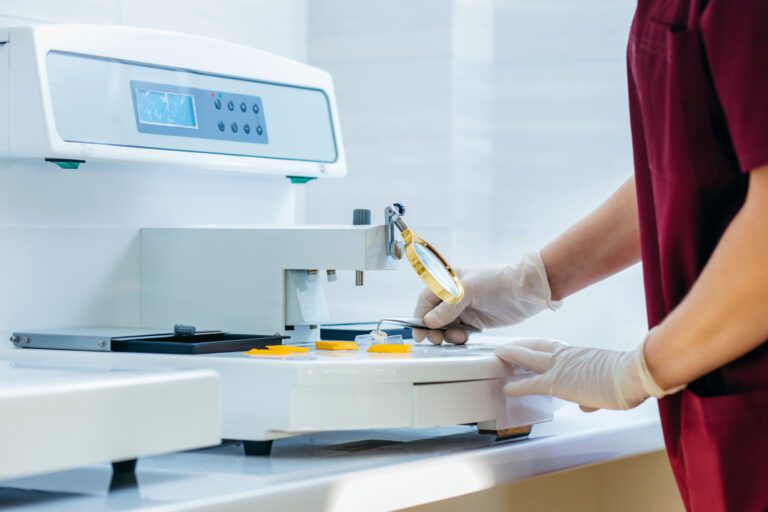You will be asked to eat a light meal 2 hours prior to the procedure. After the light meal 2 hours prior, you may have clear liquids up to the time of your procedure, but no additional solid foods.
If you are taking prescribed anticoagulants (blood thinners) such as Coumadin or Plavix, you should ask your physician for instructions prior to the procedure. Patients should not take over-the-counter aspirin or aspirin-containing medications for at least 5 days prior to their procedure. Please consult with your doctor or healthcare provider before stopping ANY medications. You will be able to drive following the procedure.
For your safety and the protection of others, we do not allow anyone other than patients in our exam rooms.
After you arrive for your appointment, you will be escorted to a procedure room, where you will be asked to change into a patient gown. You will then be asked to lie on your stomach on the examination table and to place your breast through an opening in the table. The tabletop will then be raised so that the radiologist and technologist will perform the procedure from beneath you. Your breast will be compressed like it is during a regular mammogram, and several X-ray images will be obtained in order to locate the abnormality. The radiologist will then review the images and will use a computer to select the precise area to be sampled.
The overlying skin will be cleansed, and a small amount of local anesthetic (lidocaine) will be injected into the skin and deeper tissues of the breast with a small needle. You will feel a pinch and burn similar to a bee sting while the anesthetic is injected. After the area becomes numb, the radiologist will insert the biopsy needle, take additional X-rays to ensure that the needle has been placed in the proper location, and take several small tissue samples. After all samples have been taken, the radiologist may place a tiny marker inside your breast so the exact location of the biopsy can be easily seen on future examinations. The marker is made of stainless steel or titanium and poses no health or safety risks, and you will not be able to feel or notice it after it is placed. Afterward, the technologist will apply pressure to the site for several minutes to prevent bleeding. Finally, a sterile dressing will be applied. If a biopsy marker was placed at the time of biopsy, a mammogram will be performed to document the position of the biopsy marker. At the end of the procedure you will be given an ice pack to place over the area to help reduce bruising and swelling.
The entire process takes about one hour, though the procedure itself takes 10-15 minutes. Most women feel well enough to resume their usual activities shortly after the procedure; however, exercise or strenuous activity should be avoided for 24 hours.
Occasionally, a patient experiences significant discomfort related to the procedure, though it is usually easily controlled by non-prescription pain medication. Infection can occur whenever the skin is penetrated, but the chance of infection requiring antibiotic therapy is minimal. There is also a risk of bleeding whenever the skin is penetrated which is almost always controlled at the time of the procedure. However a blood collection referred to as a hematoma may develop at the site of biopsy. In almost all cases of hematoma the body is able to reabsorb the blood over a period of time with no additional procedure needed to remove the hematoma.
For your safety and the protection of others, we do not allow anyone other than patients in our exam rooms.
After you arrive for your appointment, you will be escorted to a procedure room, where you will be asked to change into a patient gown. The first part of the procedure will seem much like your original ultrasound study. While lying on your back or turned slightly on your side, your breast will be scanned to find the abnormality, and the technologist will mark the overlying skin with a marker.
The skin will then be cleansed, and a small amount of local anesthetic (lidocaine) will be injected into the skin and deeper tissues of the breast with a small needle. You will feel a pinch and burn similar to a bee sting while the anesthetic is injected. After the area becomes numb, the radiologist will make a very small incision in the skin, insert the biopsy needle, and direct it to the location of the abnormality using the ultrasound images for guidance. After the needle is properly positioned, you will be asked to remain still as several small tissue samples are obtained. After all samples have been taken, the radiologist may place a tiny marker inside your breast so this area can be easily seen on future examinations. The marker is made of stainless steel or titanium and poses no health or safety risks, and you will not be able to feel or notice it after it is placed. Afterward, the technologist will apply pressure to the site for several minutes to prevent bleeding. Finally, a sterile dressing will be applied. If a biopsy marker was placed at the time of biopsy, a mammogram will be performed to document the position of the biopsy marker. At the end of the procedure you will be given an ice pack to place over the area to help reduce bruising and swelling.
The entire process usually takes less than an hour, though the procedure itself takes only 10-15 minutes. Most women feel well enough to resume their usual activities shortly after the procedure; however, exercise or strenuous activity should be avoided for 24 hours.
Occasionally, a patient experiences significant discomfort related to the procedure, though it is usually easily controlled by non-prescription pain medication. Infection can occur whenever the skin is penetrated, but the chance of infection requiring antibiotic therapy is minimal. There is also a risk of bleeding whenever the skin is penetrated which is almost always controlled at the time of the procedure. However a blood collection referred to as a hematoma may develop at the site of biopsy. In almost all cases of hematoma the body is able to reabsorb the blood over a period of time with no additional procedure needed to remove the hematoma.
For your safety and the protection of others, we do not allow anyone other than patients in our exam rooms.
After you arrive for your appointment, you will be escorted to a procedure room, where you will be asked to change into a patient gown. A nurse or technologist will then insert an intravenous line (IV) into a vein in your hand or arm for injection of the contrast agent. You will lie face down on a moveable exam table, and your breasts will be positioned into special openings in the table. Unlike the diagnostic MRI examination, the breast undergoing the biopsy will be held in compression in order to facilitate the biopsy. After you have been properly positioned, the radiologist and technologist will obtain MRI images and locate the abnormality to be biopsied.
The overlying skin will then be cleansed, and a small amount of local anesthetic (lidocaine) will be injected into the skin and deeper tissues of the breast with a small needle. You will feel a pinch and burn similar to a bee sting while the anesthetic is injected. After the area becomes numb, the radiologist will insert the biopsy needle and take several small tissue samples. After all samples have been taken, the radiologist may place a tiny marker inside your breast so this area can be easily seen on future examinations. The marker is made of stainless steel or titanium and poses no health or safety risks, and you will not be able to feel or notice it after it is placed. Afterward, the technologist will apply pressure to the site for several minutes to prevent bleeding. Finally, a sterile dressing will be applied. If a biopsy marker was placed at the time of biopsy, a final mammogram will be performed to document the position of the biopsy marker. At the end of the procedure you will be given an ice pack to place over the area to help reduce bruising and swelling.
The entire process takes about one hour, though the procedure itself takes 15-30 minutes. Most women feel well enough to resume their usual activities shortly after the procedure; however, exercise or strenuous activity should be avoided for 24 hours.
Occasionally, a patient experiences significant discomfort related to the procedure, though it is usually easily controlled by non-prescription pain medication. Infection can occur whenever the skin is penetrated, but the chance of infection requiring antibiotic therapy is minimal. There is also a risk of bleeding whenever the skin is penetrated which is almost always controlled at the time of the procedure. However a blood collection referred to as a hematoma may develop at the site of biopsy. In almost all cases of hematoma the body is able to reabsorb the blood over a period of time with no additional procedure needed to remove the hematoma.
For your safety and the protection of others, we do not allow anyone other than patients in our exam rooms.
• Leave the bandage on until the next morning. At that time, remove the bandage but leave the Steri-Strip (adhesive strip over the puncture site) in place.
• Do not bathe or shower for 24 hours after the biopsy. Do not go swimming or into a hot tub for three days after the procedure.
• After 24 hours you may bathe or shower with the Steri-Strip in place. The Steri-Strip will eventually come off in the shower. The edges of the Steri-Strip can be trimmed if it starts to peel off. Leave the Steri-Strip in place until it comes off on its own. Once the Steri-Strip falls off, it does not need to be replaced.
• Do not take any ibuprofen, aspirin or aspirin-containing products for three days after the biopsy. You may take regular-strength Tylenol (one to two tablets every four to six hours) for mild discomfort.
• Avoid strenuous activities or lifting heavy objects for 24 hours.
A pathologist will examine the tissue specimens and will issue a report on the findings to your doctor or healthcare provider, usually within 3-5 working days. Your doctor or healthcare provider will then be able to discuss the results with you.
Reports are also available on the Patient Portal


